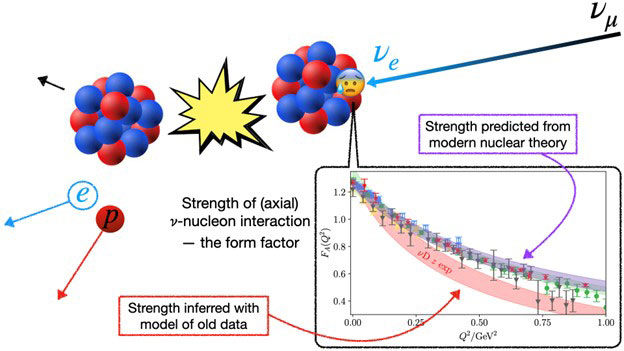Studying Crowd Behavior at MINERvA
Detector measures the energy a neutrino imparts to protons and neutrons to help explain the nature of matter and the universe.

The Science
Details on how ghost-like particles called neutrinos behave could help scientists solve the mystery of the origins of the universe. The challenge to studying neutrinos? Scientists can't measure a neutrino's energy directly. Instead, they measure the energies of particle crowds produced by neutrinos interacting with an atomic nucleus. The MINERvA experiment measured neutrino interactions with carbon, iron, and lead nuclei. With carbon, the results of the neutrinos’ interactions matched predictions of how the particles would behave. In the iron and lead, the interactions weren’t quite as expected. The results provide additional data to inform theoretical models about neutrinos, especially how they oscillate.
The Impact
Scientists need details on neutrinos’ interaction inside an atomic nucleus to precisely measure neutrinos’ energy. Neutrinos are the most abundant elementary particles in the universe that weigh something. They have no electric charge. They pass through almost everything. Measuring neutrino energy leads to understanding neutrino oscillations. Understanding oscillations will expand what we know about how to create and tailor matter.
Summary
In the energy range of many oscillation experiments, the dominant interaction process is one in which a neutrino completely scatters off a neutron inside the nucleus and produces a muon and proton. The produced proton can interact further with other particles inside the nucleus. Thus in the presence of other protons and neutrons, the distributions of the final-state particles may differ from the primary interaction. One way to see how the nucleus changes the picture is to look at the angle between two planes that define the interaction: If you think of the plane that includes the neutrino direction and the proton direction, and also the plane that includes the neutrino direction and the muon direction, those two planes should be different by 180 degrees. MINERvA can measure the angle between those two planes precisely. It turns out that these events are not all at 180 degrees apart — not even close, and the distribution of angles is different between carbon, iron, and lead.
If you are a teacher, you have to deal with this kind of situation every day. Suppose you supervise a large group of kids, and you know the individual behavior of each kid. However, when they are in a large group, each kid's behavior is affected by others, so you adjust your prediction. Think of the proton and neutrons as the kids, which are inside a bound nucleus. Your estimation of how much energy the kids have will be different once you take into account the fact that they are losing lots of energy interacting with each other, compared to when they were just sitting in separate rooms by themselves. MINERvA made a new measurement of this process by including all the events with a muon plus at least one proton and no lighter particles. The probability of a neutrino interaction is measured as a function of momentum transferred to the nucleus, which is calculated using a measurement of the proton’s energy. MINERvA carried out the measurement simultaneously on carbon, iron, and lead. If all the kids in the nucleus behaved like individuals, then the ratio of cross sections would be close to a constant that’s related to ratio of the fraction of neutrons in each target nucleus. But these ratios are not at a constant value.
This measurement also shows that the dependence on the target element (lead or iron) is not well-described in the current nuclear models and that the theorists have some homework to do before the predictions for experiments measuring oscillations will be precise. This is the first time a direct measurement of this has ever been made.
Contact
Anushree Ghosh
Federico Santa María Technical University
anushreephy@gmail.com
Funding
This work was supported by the Fermi National Accelerator Laboratory under U.S. Department of Energy (DOE), Office of Science, High Energy Physics contract DE-AC02-07CH11359 which included the MINERvA construction project. Construction support was also granted by the National Science Foundation (NSF) under award PHY-0619727 and by the University of Rochester. Support for participating scientists was provided by the following: NSF and DOE (USA); CAPES and CNPq (Brazil); CoNaCyT (Mexico); Proyecto Basal FB 0821, CONICYT PIA ACT1413, Fondecyt 3170845 and 11130133 (Chile); CONCYTEC, DGI-PUCP and IDI/IGI-UNI (Peru); and Latin American Center for Physics (Latin America).
Publications
M. Betancourt, et al. (MINERvA collaboration), “Direct measurement of nuclear dependence of charged current quasielastic-like neutrino interactions using MINERvA.” Physical Review Letters 119, 082001 (2017). [DOI: 10.1103/PhysRevLett.119.082001]
Related Links
Fermilab News at Work: Studying crowd behavior at MINERvA
Fermilab News at Work: A neutrino tale as told by a proton
Highlight Categories
Program: HEP
Performer: University , DOE Laboratory
Additional: Collaborations , Non-DOE Interagency Collaboration , International Collaboration



